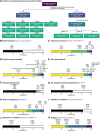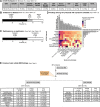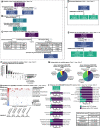This is a preprint.
Expanding the genetics and phenotypes of ocular congenital cranial dysinnervation disorders
- PMID: 38585811
- PMCID: PMC10996726
- DOI: 10.1101/2024.03.22.24304594
Expanding the genetics and phenotypes of ocular congenital cranial dysinnervation disorders
Update in
-
Expanding the genetics and phenotypes of ocular congenital cranial dysinnervation disorders.Genet Med. 2025 Apr;27(4):101216. doi: 10.1016/j.gim.2024.101216. Epub 2024 Jul 18. Genet Med. 2025. PMID: 39033378 Free PMC article.
Abstract
Purpose: To identify genetic etiologies and genotype/phenotype associations for unsolved ocular congenital cranial dysinnervation disorders (oCCDDs).
Methods: We coupled phenotyping with exome or genome sequencing of 467 pedigrees with genetically unsolved oCCDDs, integrating analyses of pedigrees, human and animal model phenotypes, and de novo variants to identify rare candidate single nucleotide variants, insertion/deletions, and structural variants disrupting protein-coding regions. Prioritized variants were classified for pathogenicity and evaluated for genotype/phenotype correlations.
Results: Analyses elucidated phenotypic subgroups, identified pathogenic/likely pathogenic variant(s) in 43/467 probands (9.2%), and prioritized variants of uncertain significance in 70/467 additional probands (15.0%). These included known and novel variants in established oCCDD genes, genes associated with syndromes that sometimes include oCCDDs (e.g., MYH10, KIF21B, TGFBR2, TUBB6), genes that fit the syndromic component of the phenotype but had no prior oCCDD association (e.g., CDK13, TGFB2), genes with no reported association with oCCDDs or the syndromic phenotypes (e.g., TUBA4A, KIF5C, CTNNA1, KLB, FGF21), and genes associated with oCCDD phenocopies that had resulted in misdiagnoses.
Conclusion: This study suggests that unsolved oCCDDs are clinically and genetically heterogeneous disorders often overlapping other Mendelian conditions and nominates many candidates for future replication and functional studies.
Conflict of interest statement
Conflict of interest D.G.M. is a paid adviser to GlaxoSmithKline, Insitro, Variant Bio and Overtone Therapeutics and has received research support from AbbVie, Astellas, Biogen, BioMarin, Eisai, Merck, Microsoft, Pfizer and Sanofi-Genzyme; none of these activities are related to the work presented here. M.E.T. is provided with research reagents and/or resources from Microsoft, Illumina, Pacific Biosciences, and Ionis Pharmaceuticals; none of these are related to the work presented here. A.O’D.L. is on the scientific advisory board for Congenica Inc. S.A.D.G. is an employee and stockholder of Regeneron Pharmaceutical.
Figures



References
-
- Senthilkumar VA, Tripathy K. Marcus Gunn Jaw-Winking Syndrome. In: StatPearls. StatPearls Publishing; 2023. https://www.ncbi.nlm.nih.gov/pubmed/32644484 - PubMed
-
- Barry BJ, Whitman MC, Hunter DG, Engle EC. Duane Syndrome. In: Adam MP, Feldman J, Mirzaa GM, et al., eds. GeneReviews. University of Washington, Seattle; 2007. https://www.ncbi.nlm.nih.gov/pubmed/20301369
Publication types
Grants and funding
LinkOut - more resources
Full Text Sources
Miscellaneous
